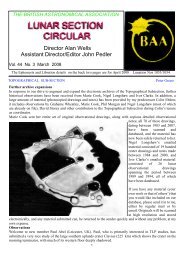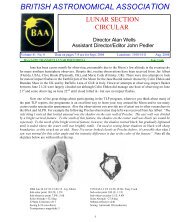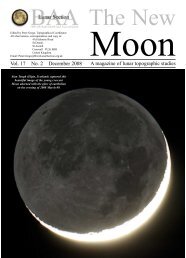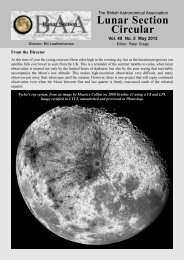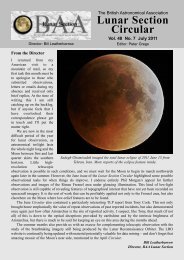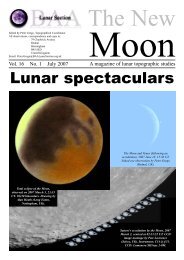Vol 47, No 4, April 2010 - BAA Lunar Section
Vol 47, No 4, April 2010 - BAA Lunar Section
Vol 47, No 4, April 2010 - BAA Lunar Section
You also want an ePaper? Increase the reach of your titles
YUMPU automatically turns print PDFs into web optimized ePapers that Google loves.
LTP to be seen from Earth. They further speculate that charge separation within part of the cloud of dust could<br />
cause coronal discharge effects. The authors also discuss how their model of gas seepage had predicted correctly<br />
the distribution of hydrated lunar regolith, within about 20 degrees of each lunar pole, discovered in<br />
2009. They do not comment though on why the Apollo instruments did not detect such large amounts of gas<br />
being added to the lunar atmosphere.<br />
Concerning the electrostatic levitation of dust particles on the Moon, Poppe and Horanyi of the University<br />
of Colorado have been carrying out computational simulations on the process in a one dimensional model,<br />
The theory goes that ultraviolet light from the Sun causes photoemission from the lunar surface and solar<br />
wind plasma should give the lunar surface a negative charge. However the electrical current from the photoemission<br />
is roughly ten times greater than the solar wind electrical current and so the lunar surface is charged<br />
positively. Something called a photoelectron sheath develops and can form up to several meters thick above<br />
the surface. They find that downward directional electric fields in the photoelectron sheath limit the height to<br />
which dust particles can levitate and it becomes significantly more difficult to levitate particles larger than<br />
0.15 microns in size. For future work they will model the process in two dimensional simulations and will<br />
also vary UV flux and solar wind conditions, but for now their models dispute some of the evidence for electrostatic<br />
dust particles attaining much altitude at all.<br />
Conversely Glenar et al. (New Mexico State University) discuss whether the 1994 Clementine mission<br />
observed horizon glow from dust particles suspended a hundred km above the lunar surface from the spacecraft’s<br />
star tracker cameras! Their conclusions, after removing the effects of zodiacal light, and the corona etc,<br />
hint that it does exist and they are now studying the spatial distribution of the horizon glow along the limb.<br />
Jackson et al. (Goddard Space Flight Center) submitted an abstract to the conference, expressing concern<br />
about tribo-electric discharge hazard faced by astronauts, especially at the polar regions near to permanently<br />
shadowed craters. Hartzell and Scheeres of the University of Colorado have been studying what happens if<br />
lunar water is present on dust particles at the parts per million level. There conclusion is that this reduces the<br />
cohesive force between dust particles and the surface and this can increase the chances of levitation should a<br />
particle become charged, furthermore the effect would be more prevalent at sunrise than at sunset and this is<br />
what is observed. They do however not discuss the precise mechanism for charging; I guess a lot of theoretical<br />
work still needs to be achieved in this research area to match the observational evidence!<br />
Finally, you may be interested to know that LRO’s Lyman Alpha Mapping Project (LAMP), a far ultraviolet<br />
imaging spectrograph that detected molecular hydrogen, mercury, calcium and magnesium volatiles in<br />
the ejecta plume of the LCROSS impact, will be used to monitor horizon glow at dawn, according to<br />
Gladstone and the LAMP team from the Southwest Research Institute. They hope to detect gaseous emissions<br />
from the surface, sodium emissions, dust particles during meteor showers, and other effects during crossings<br />
of the Earth’s magnetotail.<br />
Figure 2. Flock of birds passing across the Moon from Aberystwyth. To view as a 3D Anaglyph, please use<br />
red and green/blue glasses with red over the left eye and Green/blue over the right eye. The left and right<br />
images, in this stereo pair, are separated by 1/60th second<br />
<strong>BAA</strong> <strong>Lunar</strong> <strong>Section</strong> Circular <strong>Vol</strong>. <strong>47</strong> <strong>No</strong>. 4 <strong>April</strong> <strong>2010</strong> 15



